A Tart Is Always a Pie. But a Pie’s Not Always a Tart
Lessons I learned from baking lemon curd and orange custard tarts.
Recently we hosted an open house at Stella Porta. I decided to put together some fancy desserts for the shindig. I have to admit that I have always fancied tarts, especially the fruity kinds, think crisp shell, silky filling, nothing too crazy.
Previously I wrote about A Different Kind of Pi Project. I tried it again and, short of almost overbaking the crust, that run taught me enough not to screw it up this time. With that figured out, it was time to focus on fillings. While I like the flavor of orange custard fruit tarts, I also wanted to try a traditional Italian Limoncello pistachio tart, something from my own heritage.
Pâte Sucrée, aka The Crust
Before we talk about the filling, let me say a few words about the crust.
The crust is the same one I used in my earlier Pi Project post, a simple butter, sugar, and flour base, but this time I went with a proper blind bake. I picked up some tart pans from a local restaurant supply store, made the dough earlier in the week, and tucked it in the freezer. On Friday I moved it to the fridge to thaw slowly. Saturday I rolled the dough out into thin rounds and pressed them into the tart pans.
I also picked up a few useful tricks from a Martha Stewart Pâte Sucrée video, including using the rolling pin over the top of the pans to cleanly trim the dough.
These crusts were blind baked. I lined them with parchment and filled them with “pie weights,” in my case a jar of old black beans. The point is to weigh the dough down so it doesn’t bubble or shrink while the fat melts and the structure sets. I suppose I could have used double-aught buckshot, but lead doesn’t do well in the oven. You can at least reuse the beans.
I baked the shells until they were set and lightly golden before adding any filling. Blind baking keeps the crust from puffing up or shrinking and makes sure the bottom stays crisp instead of turning soggy once the custard goes in.
These shells were baked and ready on Saturday. I slid them onto a tray, sealed them up airtight in Ziploc bags, and tucked the whole thing in the fridge. Keeping air out helps prevent oxidation so the crust stays crisp and the flavor clean until Sunday.
What’s nice about the tart pans is that the sides slip off. I leave them on while I fill the shells so they hold their shape, then pop them off before serving for a clean edge. This design saves a lot of unnecessary cussing. Letting the tarts warm slightly from fridge-cold makes the crust less brittle and helps the ring slide off without cracking an edge. Be careful not to lift them from the middle or the bottom can drop out before you’re ready.
Limoncello Pistachio Tart
As part of teaching myself to cook, I picked up a few books; among them was Dolci!: American Baking with an Italian Accent by Renato Poliafito. His recipe for a Limoncello pistachio tart caught my eye. The original ingredients called for Amalfi lemons, which are not too common in Arkansas. Poliafito substitutes limoncello liqueur. While I’m sure you could pick this up at any high-quality packy in NYC, it’s rarer than a Mets fan in Arkansas.
What I did have plenty of in my storage pantry, for reasons that escape me, were jars of Bonne Maman Lemon Curd. So instead of chasing the unobtainium of Amalfi lemons or limoncello, I reckoned I’d work with what I had and tune the sweetness and texture with the same fineness I’d use on a chopper’s carburetor.
Lemon curd is basically halfway to what you’d build for a custard tart anyway. It’s egg yolks, sugar, lemon juice, and butter cooked gently until thick and glossy. That’s not far from the eggs, sugar, milk, and starch I’d use for an orange custard, just heavier on citrus and butter, lighter on dairy. So starting with a jar of curd meant most of the work was already done; it just needed a little tweaking.
Jarred lemon curd is an emulsion of egg yolk proteins, sugar, lemon juice, and butter. Over time and with commercial production it tends to be cooked enough to stabilize, but that also drives off some volatile lemon aromatics and pushes the pH slightly higher as the acid is buffered by the butter and yolks. Adding fresh lemon juice drops the pH back down, you literally increase acidity, which makes the flavor pop brighter and sharper.
The cream does the opposite in a complementary way: it brings in additional butterfat and milk solids, which dilute the sweetness, reduce perceived sharpness, and coat the palate so the acid doesn’t feel harsh. Fat globules also stabilize the emulsion and give a smoother mouthfeel. Done in small amounts, this keeps the curd thick while shifting the taste from cloying toward balanced and lively.
We’d just gotten some milk from a neighbor’s cow, raw milk, not that stuff that comes in boxes from the supermarket. Heated it to 161 °F for 15 seconds to pasteurize, enough to kill off the nasties that can ride along in raw milk while keeping the flavor fresh. And in spite of what internet influencers say, pasteurizing doesn’t wreck the good stuff: proteins, fats, and minerals stay the same. You lose a little vitamin C and some enzymes, but nothing meaningful compared to the risk of raw milk bugs.
We let the milk cool in the fridge for a day or so and skimmed the cream that rose to the top. That cream is what I stirred into the lemon curd to mellow it out.
Of course, no plan survives first contact with the enemy. Once I mixed in the fresh cream and lemon juice, the curd went soft and refused to set in the fridge. Fresh cream doesn’t behave like the ultra-processed stuff from the store; it’s looser and can thin a custard.
My solution was to gently reheat the mixture, whisk in a bit of gelatin, and let it cool again. That locked the structure back down so it would hold in the tart shells. Instead of blooming the gelatin in cold water first, I just sprinkled it over the warm curd and whisked, basically blooming it in place. The heat was enough to melt and disperse it evenly.
Gelatin starts as collagen, the connective tissue protein in animals. When it is processed, the long collagen chains break into shorter ones that dissolve in hot liquid. As the liquid cools, those chains tangle and form a loose three-dimensional network that traps water and thickens the mixture. The strength of that network depends on how much gelatin you add. Too much and the result is rubbery, too little and it slumps.
Acid and fat change how that network forms. Lemon juice weakens the gel slightly, so very tart mixtures sometimes need a bit more gelatin. Cream and butter coat some of the water and soften the set, giving a smoother mouthfeel but a looser structure. For custards and curds, about three-quarters to one teaspoon powdered gelatin per cup gives a sliceable but still creamy texture. Hydrate it well, avoid boiling after it dissolves, and it will set clean and stable.
This job was done on Friday. I let the finished curd cool in the fridge until game day on Sunday. This way it was ready to go when it was time to assemble the tarts.
Pistachios
The other half of a Limoncello pistachio tart is of course the pistachios. They’re more than just garnish; they add a nutty backbone and a little crunch against all that citrus and cream.
It was low tide for finding any raw, unsalted pistachios locally, so I grabbed a bag of Wonderful Pistachios instead. In theory I’d rather scoop unsalted nuts from a bulk bin and roast them myself, but those bins can be stale; nuts sit exposed to air and light for who knows how long. These bagged nuts are roasted and lightly salted, which actually keeps them fresher and more stable. At least they use sea salt instead of iodized, so the flavor stays clean without that metallic edge.
Commercial “toasted and salted” nuts are roasted hot and fast because the goal is shelf life and snack appeal. High heat drives off moisture quickly so they stay crisp for months and toasts the sugars and amino acids on the nut’s surface for extra browning. That deep roasted smell is there to make you want a handful. They’re also coated with oil and fine salt so the seasoning sticks and hits your tongue right away. It’s engineered to light up the same reward circuits that crave potato chips: fat, salt, and roasted notes trigger a “keep eating” response.
In a dessert that effect can get in the way. The dark roast can taste bitter next to delicate citrus, and the oil can bleed into your custard or crust. The heavy salt doesn’t just make the filling salty; it also dulls the tart’s acidity and balance. So controlling roast and salt yourself lets the pistachio flavor support the lemon and cream instead of hijacking it.
To make the best of what I had, I rinsed the salted pistachios under cold water to wash away surface salt, then dried them thoroughly on a towel. After that I spread them on a sheet pan and put them in a 300 °F oven for about 5–7 minutes, just until fragrant. The moderate heat wakes the nut oils and rounds out the flavor without risking burnt edges. Cooling them before chopping keeps the texture crisp and avoids smearing the oils into a paste.
I was short on time that day, and rather than chopping the pistachios, I tried the food processor. It was a friggin’ disaster: it spun the nuts into uneven chunks and an oily paste. The coffee bean grinder worked better; short pulses kept the nuts cool and gave me a more even chop without smearing the oils. Using a knife would have been better. Attempting the shortcut cost me more time.
After grinding, I sifted the pieces through a mesh strainer to separate the fine dust from the larger bits. The dust is great for sprinkling on top for color, but too much mixed into the filling can clump and turn pasty when it hits moisture.
I toasted the pistachios on Friday, bagged them up, and set them aside for Sunday’s assembly. That way they stayed crisp and ready to sprinkle once the tarts were filled.
On Sunday morning I pulled the tart crusts out of the fridge and gave them a quick refresh in a 350 °F oven for a few minutes to crisp back up. A short bake drives off fridge moisture and keeps the bottoms from going soggy once the filling goes in. Once the shells cooled, I filled them with the custard and lemon curd mix, smoothing the tops so they’d be ready for garnish.
For garnish I ran a lemon partway through the same hand-crank peeler I used on the apple pie from my previous post. It turned out some surprisingly nice little lemon curls, bright yellow spirals that looked fancier than the effort it took.
The Fruit Tart
The fruit tart was the showpiece: bright, glossy, and a little fussier than the pistachio tart. The base is a smooth orange custard, which takes more hands-on cooking than the lemon curd mix, but the payoff is a deep citrus flavor that is not too sweet.
Here’s my bill of materials for the build:
3 tablespoons flour
2 tablespoons arrowroot
½ cup granulated sugar
¼ teaspoon sea salt
2 eggs (fresh from my chickens)
2 cups pasteurized milk
1 tablespoon unsalted butter
1 vanilla bean, split and scraped
Zest of one lemon and one orange, with a little juice from each
A small amount of gelatin, bloomed and added later for extra set
Flour and arrowroot thicken and give body without clouding; sugar balances tartness and helps the eggs set gently. Eggs form the custard’s backbone when heated. Milk adds creaminess, butter smooths and enriches, and vanilla gives warmth. Citrus zest and juice deliver the bright edge, and the gelatin helps the custard hold shape when cut.
Here’s how I built it:
In a medium bowl I whisked together the flour, arrowroot, sugar, salt, and eggs until it looked smooth and lump-free.
In a saucepan I heated the milk with the lemon and orange zest and the scraped-out vanilla bean (pod and all) just until it was steaming but not boiling.
Time to temper the eggs. I slowly drizzled a ladle of the hot milk into the egg mixture while whisking like mad. The goal is to bring the eggs up to temp gently so they don’t scramble later.
Then I poured the warmed egg mix back into the saucepan with the rest of the hot milk, still whisking.
I cooked it over medium heat, stirring constantly, until it thickened enough to coat the back of a spoon, about 170 to 175 °F if you check. Don’t let it boil hard or you’ll break it.
Off the heat, I fished out the vanilla pod and big zest strips and whisked in the butter until smooth and glossy.
For extra insurance, I bloomed a little gelatin in cold water, then stirred it into the hot custard until fully melted.
Some people strain the custard to get that silky French-patisserie finish. But we’re not city slickers. I skipped the strainer and left the tiny zest flecks in for a little honest texture.
I scooped the custard into a glass bowl, pressed plastic wrap right onto the surface to keep a skin from forming, and let it cool before tucking it into the fridge until filling time.
On Sunday it was game prep time. I pulled the tart crusts from the fridge and gave them a quick warm-up in a 350 °F oven to bring back the crisp. Then I scooped in the chilled custard and spread it out with a spatula like I was finishing a cement driveway. Not fancy, just smooth and level enough to hold the fruit.
Then it was time for the art show. I sliced up strawberries, blueberries, kiwi and of course raspberries. The colors looked electric against the custard. I started laying strawberries in a ring, then tucked kiwi slices for contrast and dropped blueberries into the gaps like grout. The little tarts each got their own pattern; not a single one came out the same, but all of them looked fresh and alive.
Some people finish fruit tarts with a glossy apricot glaze, melted jam brushed on to make everything shine and hold up longer. I skipped it this time; I liked the fresh, natural look and didn’t need them to keep for days.
In prep for the open house, I moved both the fruit and lemon tarts out to the walk-in cooler by our garden wash/pack station, safe from curious dogs and the October Arkansas heat.
One Tart at a Time
Another project in the books and another skill under the belt. Dessert prep this time. Between the custard, the pistachios, and the fruit work, I learned a lot and fed a crowd. The tarts looked good and tasted better. I got plenty of compliments, but the real reward was the satisfaction of learning another skill.
I did not buy them; I built them. Crust, custard, fruit, and all. Next time maybe I will hunt down Amalfi lemons or a bottle of limoncello, but honestly, I am happy with what came out of the kitchen.
Not bad for a country cook still figuring it out one tart at a time.
Time to get back to the shop and the Raspberry Pi projects waiting on the bench.


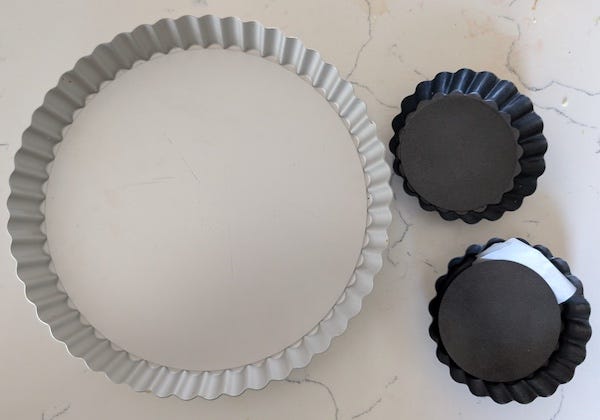

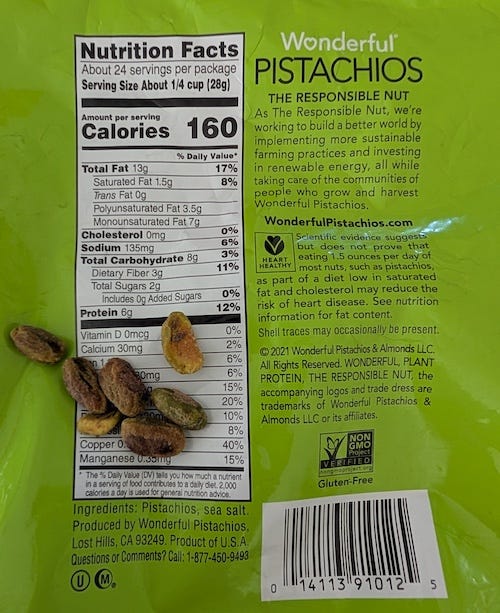
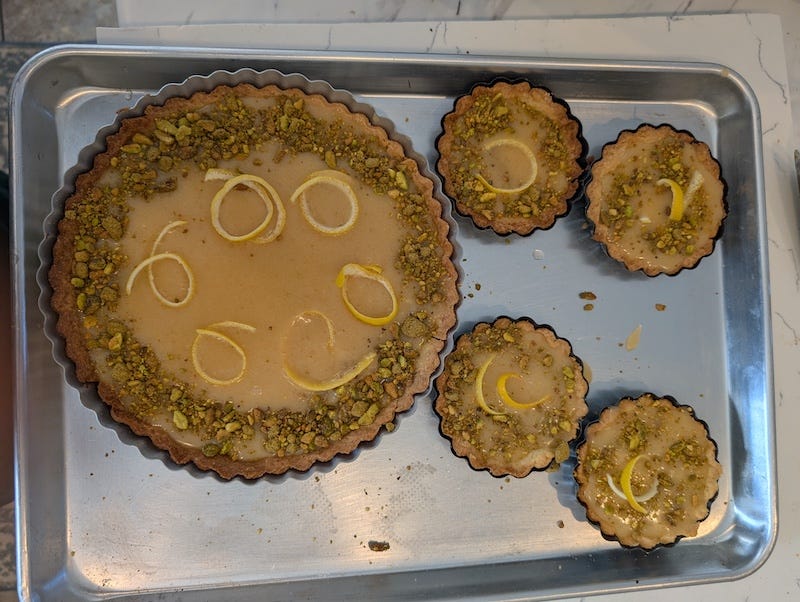
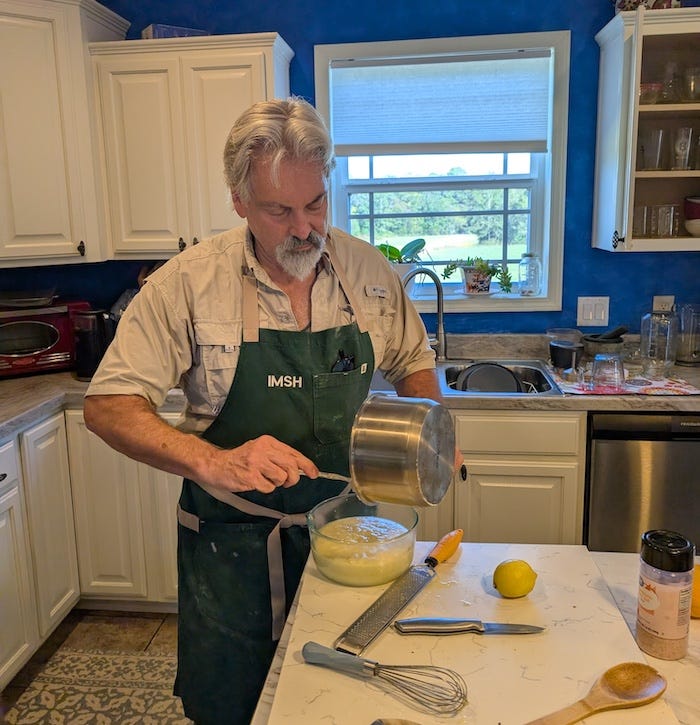
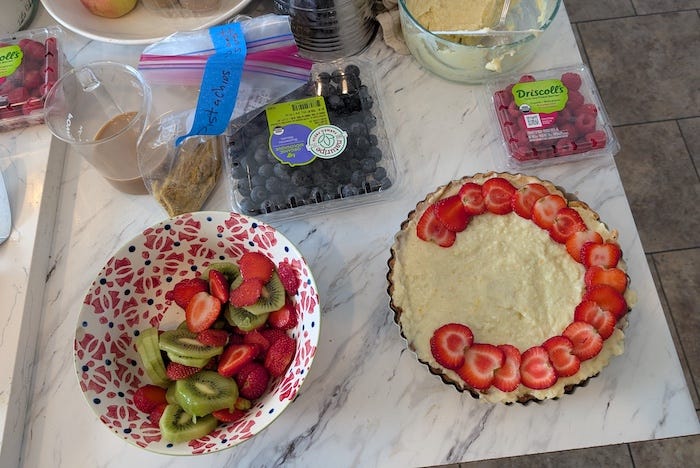
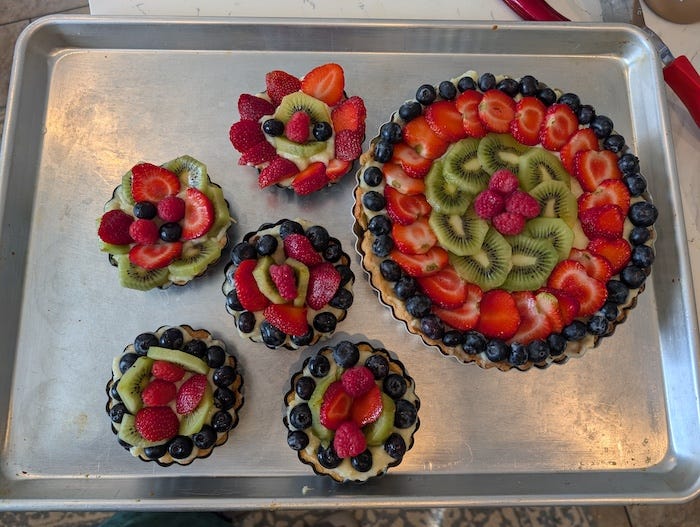
Best lemon tart I ever ate. Hands down.